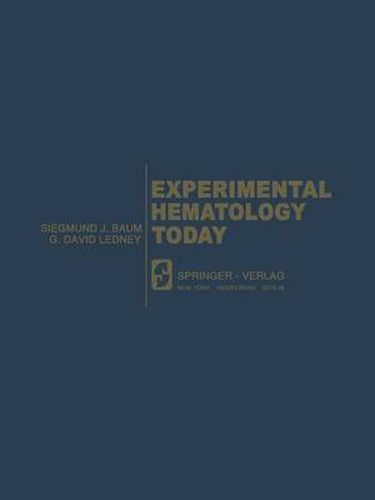Readings Newsletter
Become a Readings Member to make your shopping experience even easier.
Sign in or sign up for free!
You’re not far away from qualifying for FREE standard shipping within Australia
You’ve qualified for FREE standard shipping within Australia
The cart is loading…






This title is printed to order. This book may have been self-published. If so, we cannot guarantee the quality of the content. In the main most books will have gone through the editing process however some may not. We therefore suggest that you be aware of this before ordering this book. If in doubt check either the author or publisher’s details as we are unable to accept any returns unless they are faulty. Please contact us if you have any questions.
It is perhaps not too much of an exaggeration to claim that experimental hematology as it flourishes today originated largely from the pioneering attempts to protect lethally radiated animals (1) by shielding of hemopoietic tissues by L. O. Jacobson (9), and (2) by treatment with bone marrow suspensions by E. Lorenz and his col- laborators (12). The site chosen for this annual meeting of the International Society for Experi- mental Hematology is given a special historic sig- nificance by the fact that it was 25 years ago that the first publication on this subject by Lorenz ap- peared from his laboratory at the National Insti- tutes of Health. Lorenz’s discovery marked the beginning of a period which lasted until 1956, during which the protection afforded by hemopoietic cell suspensions was confirmed by many. This soon led to an intensive scientific de- bate on the mechanism of this protective effect: was it due to a humoral factor produced and pro- vided by the bone marrow-as Lorenz The Appearance of postulated-or to transplantation and subsequent proliferation of hemop- etic cells? This question was defini- 1 the Multipotential tively answered in 1956 by evidence from three different laboratories (7, 15, 26), which demonstrated the origin of the cells Hemopoietic in the repopulated tissues using a variety of cellu- lar and immunologic markers. By the same token, these contributions marked the birth of radiation Stem Cell chimeras.
$9.00 standard shipping within Australia
FREE standard shipping within Australia for orders over $100.00
Express & International shipping calculated at checkout
This title is printed to order. This book may have been self-published. If so, we cannot guarantee the quality of the content. In the main most books will have gone through the editing process however some may not. We therefore suggest that you be aware of this before ordering this book. If in doubt check either the author or publisher’s details as we are unable to accept any returns unless they are faulty. Please contact us if you have any questions.
It is perhaps not too much of an exaggeration to claim that experimental hematology as it flourishes today originated largely from the pioneering attempts to protect lethally radiated animals (1) by shielding of hemopoietic tissues by L. O. Jacobson (9), and (2) by treatment with bone marrow suspensions by E. Lorenz and his col- laborators (12). The site chosen for this annual meeting of the International Society for Experi- mental Hematology is given a special historic sig- nificance by the fact that it was 25 years ago that the first publication on this subject by Lorenz ap- peared from his laboratory at the National Insti- tutes of Health. Lorenz’s discovery marked the beginning of a period which lasted until 1956, during which the protection afforded by hemopoietic cell suspensions was confirmed by many. This soon led to an intensive scientific de- bate on the mechanism of this protective effect: was it due to a humoral factor produced and pro- vided by the bone marrow-as Lorenz The Appearance of postulated-or to transplantation and subsequent proliferation of hemop- etic cells? This question was defini- 1 the Multipotential tively answered in 1956 by evidence from three different laboratories (7, 15, 26), which demonstrated the origin of the cells Hemopoietic in the repopulated tissues using a variety of cellu- lar and immunologic markers. By the same token, these contributions marked the birth of radiation Stem Cell chimeras.